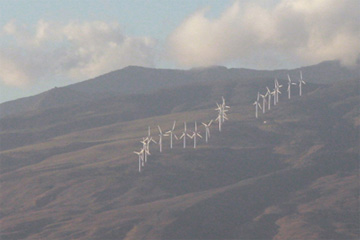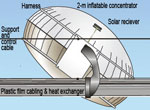|
|
Wind power may be the key to a clean energy revolution: a new study in the Proceedings of the National Academy of Science finds that wind power could provide for the entire world’s current and future energy needs.
To estimate the earth’s capacity for wind power, the researchers first sectioned the globe into areas of approximately 3,300 square kilometers (1,274 square miles) and surveyed local wind speeds every six hours. They imagined 2.5 megawatt turbines crisscrossing the terrestrial globe, excluding “areas classified as forested, areas occupied by permanent snow or ice, areas covered by water, and areas identified as either developed or urban,” according to the paper. They also included the possibility of 3.6 megawatt offshore wind turbines, but restricted them to 50 nautical miles off the coast and to oceans depths less than 200 meters.
Using this criteria the researchers found that wind energy could not only supply all of the world’s energy requirements, but it could provide over forty times the world’s current electrical consumption and over five times the global use of total energy needs.
Turning to the world’s two largest carbon emitters, China and the United States, the researchers found that wind power has the potential to easily supply both nations.
 Windmill for pumping water in Kenya  Wind turbines for power generation in Maui. |
“Large-scale development of wind power in China could allow for close to an 18-fold increase in electricity supply relative to consumption reported for 2005,” the researchers write. “The bulk of this wind power, 89%, could be derived from onshore installations. The potential for wind power in the U.S. is even greater, 23 times larger than current electricity consumption, the bulk of which, 84%, could be supplied onshore.”
Expanding their view to the top ten carbon emitters, the researchers found that Russia, Canada, and the United States (in this order) had the greatest capacity for wind power. However, they note that much of the area available for wind power in Russia and Canada is far from any cities, making their construction costly. In addition, the authors note that the public may oppose wind turbines in particular areas, especially remote, ecologically sensitive regions. Still, they conclude that “despite these limitations, it is clear that wind power could make a significant contribution to the demand for electricity” in most high carbon emitting countries.
Xi Lu, Michael McElroy, and Juha Kiviluoma. Global potential for wind generated electricity. PNAS Early Online Edition for the week of June 22, 2009. doi/10.1073/pnas.0904101106
Related articles
Wind energy jobs now exceed coal mining jobs
(02/01/2009) Wind industry jobs now outnumber those in coal mining, reports CNNMoney.
How do wind turbines kill bats?
(08/25/2008) Numerous studies have shown that migratory bats are undergoing large fatalities due to wind turbines. Far more bats die due to wind turbines than birds, though they generally receive less attention. Now, researchers writing in Current Biology believe they know why bats are more susceptible to wind turbine fatalities.
Oceans hold vast potential for wind power
(07/09/2008) The North Pacific, Tasmania, New Zealand, Tierra del Fuego in South America, and the mid-latitudes of the Atlantic and Pacific oceans are potential locations for wind power generation, according to new satellite data from NASA.
Whale biomimicry inspires better wind turbines
(07/07/2008) By studying and mimicking the characteristics of the flippers, fins and tails of whales and dolphins, engineers have devised more a efficient way to generate wind power, reports a researcher presenting at the Society for Experimental Biology’s Annual Meeting in Marseille, France.
Balloon technology could cut cost of solar energy 90% by 2010

(02/21/2007) With high energy prices and mounting concerns over human-induced climate change, there is intense interest in renewable energy, especially solar, which produces no pollution and is readily available in the form of sunlight. In recent years, however, the solar energy market has been hampered by supply shortages of refined silicon, the critical resource needed for solar cell fabrication. Further, because solar installations traditionally require a large surface area to capture as much sunlight as possible, solar arrays often take up real estate, occupying land used agricultural production and other purposes. Without government subsidies, solar is not presently viable in many areas.